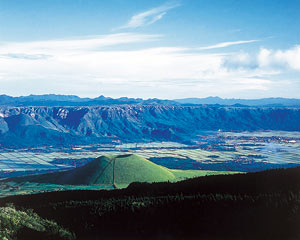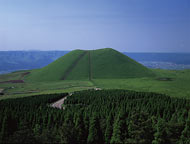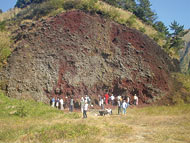4.Komezuka Geosite

Descending slightly from Nakadake Crater brings you to Komezuka, a picture-perfect scoria cone with a circular indentation in the top. Despite its diminutive height of just 80 m, Komezuka is a proper volcano, the indented peak of which offers evidence of past eruptions. The gentle slopes are covered in grass that changes from soft green in spring to desolate brown in winter. Contrasting dramatically with the jaggedly majestic scenery surrounding it, Komezuka is a popular attraction for photographers.
Visitors to Kami-komezuka can observe a cross section of the scoria cone, which has an unusually symmetrical form. Scoria is a type of volcanic rock that resembles black pumice stone, with many tiny holes in it. The holes are formed when magma expelled by a volcanic eruption cools quickly, hardening around the tunnels of escaping air. In this sense Komezuka's scoria connects visitors to the moment millennia ago when the volcano erupted.

Komezuka
A typical scoria cone formed about 2,000 years ago, Komezuka is among the most symmetrical cones of its type in Japan. The hill measures approximately 380 m across at the base and 80 meters high. During the eruption that formed the hill a large quantity of basalt lava was deposited to the north and west. Climbing is currently prohibited on Komezuka to allow the grass to recover from past damage.

